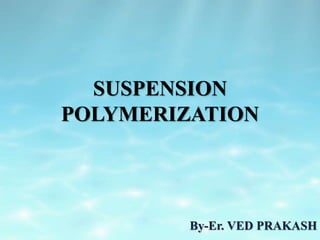
Suspension polymerization
- 2. CONTENTS 1) INTRODUCTION 2) OBJECTIVES 3) METHOD OF POLYMERIZATION 4) FLOW DIAGRAM 5) MODEL OF SUSPENSION POLYMERIZATION 6) ADVANTAGES 7) DISADVANTAGES 8) ADVANCEMENT IN THE FIELD OF SUSPENSION POLYMERIZATION 9) CONCLUSION
- 3. INTRODUCTION Suspension Polymerization is a heterogeneous radical polymerization process that uses mechanical agitation to mix a monomer or mixture of monomers in a liquid phase, such as water, while the monomers polymerize, forming spheres of polymer. This process is used in the production of many commercial resins, including Poly Vinyl Chloride (PVC), a widely used plastic styrene resins including Poly Styrene, Expanded Poly Styrene (EPS), and High Impact Poly Styrene (HIPS), as well as Poly Styrene Acrylonitrile (SAN) and Poly Methylmethacrylate (PMMA).
- 4. OBJECTIVES Suspension polymerization is most commonly used as Industrial Manufacturing method in ordr to get polymer for forming material such as poly styrene, poly methylmethacrylate, poly vinyl acetate, poly vinyl chloride. A polymer with a high degree polymerization is obtained with the polymerization and generated polymer isolation is easy. Suspension polymerization is commonly used to produce microne sized (10-1000 micrometer) polymer beads, in which the final particle size distribution is an important end use property. Suspension polymerization is suitable for preparing medium to high molecular weight products. Suspension polymerization is suitable for Free-radical Polymerizatin and Poly condensation Polymerisation.
- 5. METHOD OF POLYMERIZATION In this method the water insoluble monomer is dispersed as large droplets of size 0.1 to 1 mm in water. Initiators used are monomer soluble such as Dibenzoyl peroxide. Thus polymer is produced in heterogeneous medium. The dispersion is maintained by continuous agitation and the droplets are prevented to coalesce ( unite or merge) by adding small quantity of stablizers. The stablizers used are PVA, Gelatin, Cellulose are used along with inorganic stablizers such as Kaolin, Magnesium silicate, Aluminium hydroxide, Calcium/Magnesium phosphate, etc. As it concerns with droplets, each droplet is tiny bulk reactor.
- 6. METHOD OF POLYMERIZATION The polymerization takes place inside the droplet and product formed being insoluble in water. The product separated out in the form of spherical pearls or beads of polymer. Hence the technique is also known as Pearl Polymerization/Granular Polymerization/ Bead polymerization. The polymer formed is isolated only by filteration of the beads and removal of surface active agents and protective colloids by water washing. Washed and dried product can be used for moulding or used as adhesive by dissolving in a suitable solvent.
- 7. FLOW DIAGRAM
- 9. ADVANTAGES The process is comparatively cheap as it involves only water instead of solvents. Viscosity increase is negligible. Agitation and temperature control is easy. Product isolation is easy since the product is insoluble in water. Polymer produced may be used directly used as polymeric suspension. Good heat transfer. The purity of obtained polymer is high. Suitable for preparing high molecular weight products.
- 10. DISADVANTAGES This method can be adopted only for water insoluble monomers. It is difficult to control polymer size. Suspension polymerization is highly agitation sensitive. Larger volume of reactor is taken up by water. The method can’t be used for tacky polymers such as elastomers because of the tendency for agglomeration of polymer particles. Need extra process in washing out suspending agent/ contaminants and drying the polymer beads. Polymer beads may stick together and may be contaminated with suspending agent.
- 11. ADVANCEMENT IN THE FIELD OF SUSPENSION POLYMERIZATION Polymer Nanocomposites synthesized by suspension polymerization technique revolutionized the field of composites using advancements such as use of reactive surfactants, modified initiators, advanced clay surface modifications. Synthesis of macroporous polymer (PS) particles by suspension polymerization in water in Supercritical Carbon dioxide (sc-CO2) medium using poly vinyl alcohol (PVA) as stabilizer, azobisisobutyronitrile (AIBN) as initiator. Synthesis of magnetic polymer beads and the magnetic properties of polymer beads are determined by embedded magnetic particles. Among these particles, metal oxides are often preferred over pure metals beacause they are more stable to oxidation.
- 12. CONCLUSION Suspension polymerization is the most preferred technique in the polymerization, it gives a complex to other techniques of polymerization like Emulsion, Bulk, Solution Polymerization. Low viscosity, simple polymer isolation and easy thermal control makes this process of paramount importance. While sensitiveness to agitation, post operations and particle size is less controllable in suspension polymerization.